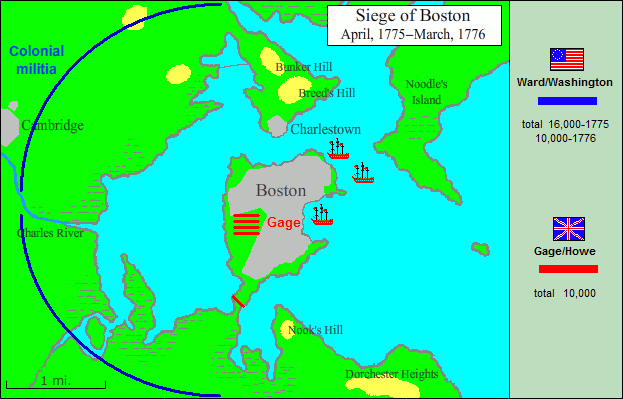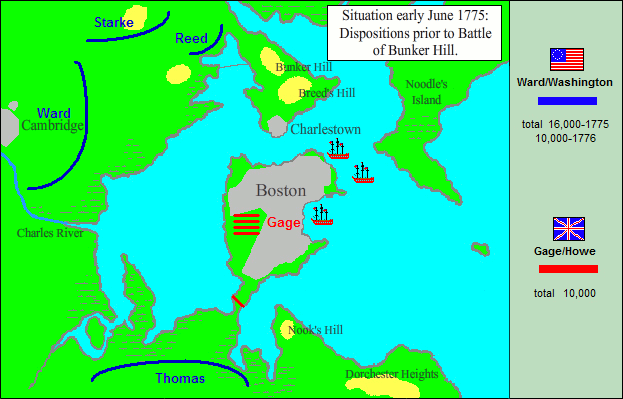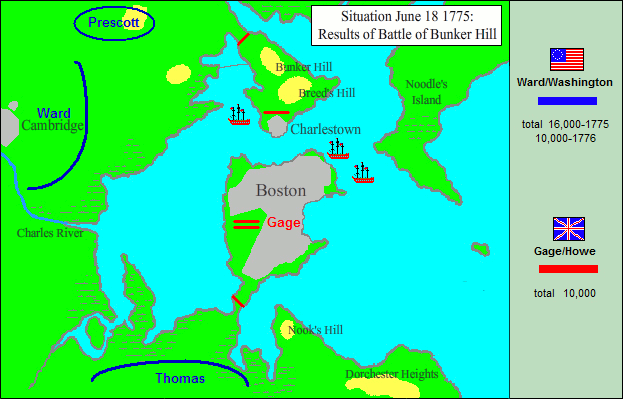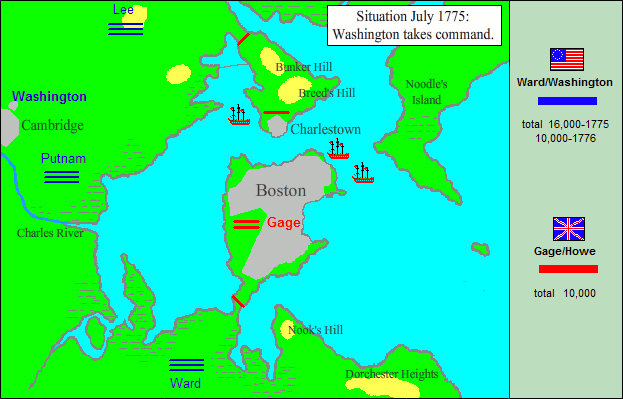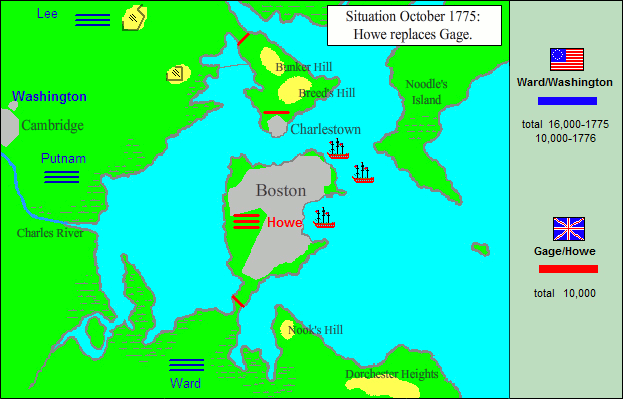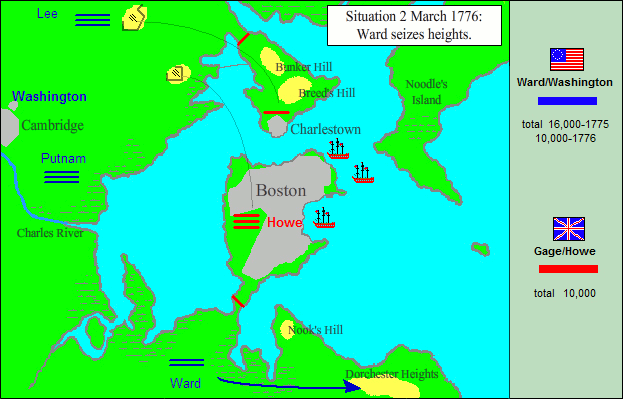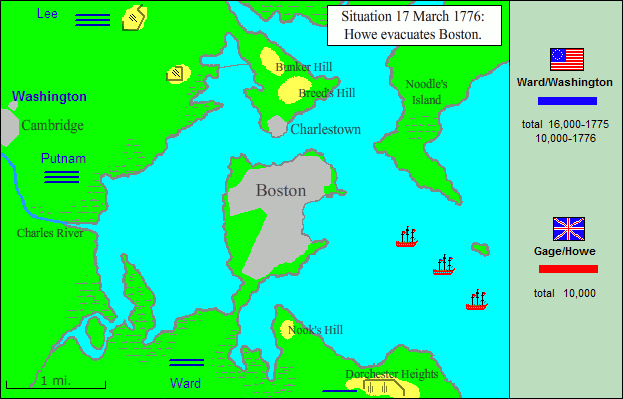The Siege of Boston
Good God, these fellows have done more work in one night than
I could have made my army do in three months.
–Sir William Howe, of the American ramparts on Dorchester Heights
While southern Patriots were repelling British efforts along the coast of the Carolinas, back in Boston, despite chronic shortages of every needful thing, General Washington had been brooding for some time on his “utmost wish,” namely the chance to “put a final end to the war and restore peace and tranquility so much to be wished for.” In mid-February, he called his generals to a council of war and put before them a daring plan. Holding his lines with a skeletal force, he would make a “bold and resolute push” across the Back Bay ice and overwhelm the redcoats with speed and surprise. It is said that councils of war never vote for battle; this one would prove no exception, but perhaps not unreasonably. British strength, as it turned out, was higher than Washington thought, and in any case he lacked the powder to sustain the bombardment his generals believed crucial to a successful attack. Washington eventually agreed, admitting that “the irksomeness of my situation… might have inclined me to put more to the hazard than was consistent with prudence.”
But if Washington still lacked powder, he did not lack guns. Fifty-nine heavy guns that had ornamented the walls of Fort Ticonderoga were now at his command, all due to the extraordinary work of Henry Knox, his chief of artillery. An unlikely soldier, this “very fat but very active young man”–in Washington’s words–had been a Boston bookseller in peace and had taught himself the rudiments of the artilleryman’s trade from his own books. Washington took an immediate liking to his “jubilant personality” and came to respect his energy and ability. Accordingly, he sent him in the dead of winter to Ticonderoga to bring those guns–sixty tons in all–to the gates of Boston. If young Knox was portly, he was not soft. Loading his guns on sledges on the western shore of Lake Champlain, he hauled them by ox-power and main strength through the Taconic Mountains, and up the rutted tracks of the Berkshires. From first light to last, the column trudged along through terrible snows and more terrible thaws, fetching up at last in Cambridge and presenting Washington with “a noble train of artillery.” The arrival of these guns may have in part inspired his initial plan to attack across the ice. But as spring drew near and the ice began to break up, Washington thought anew about how to use those guns to best effect. His most nagging anxiety at this point was that Howe might evacuate Boston of his own free will before he could be brought to battle. Signs of an impending movement were unmistakable: the steady gathering of British shipping in the harbor. New York was the likely destination, in which case Washington would find himself on much more perilous ground, forced to defend an island against the masters of the sea. In response, he resolved to destroy the redcoat army before that day came, and believed he knew how to do so.
This plan aimed at the high ground on the Dorchester peninsula just two miles from Boston. Heavy guns posted here, as Washington wrote, would “command a great part of the town and almost the whole harbor.” But Washington wanted to do a very great deal more than simply tighten the screws of this siege. Once Americans were dug in on Dorchester Heights, he reasoned, Howe would be compelled by both military necessity and his own sense of honor to come out of his stronghold and attack. It was not hard to imagine the Heights littered with redcoat dead and wounded like Breed’s Hill last June. But as costly as that battle had been to the regulars, it had been a wasted opportunity for the Americans in Washington’s view. As the sun went down on that terrible day, the British were in disordered pursuit of the retreating Rebels, strung out and fought out–and acutely vulnerable to counterattack, either at Charlestown or elsewhere along the British lines. William Prescott had seen the opportunity at the time and demanded a thousand fresh men from Ward to complete the destruction of Howe’s corps, but Ward had seen only chaos and danger. Washington too was mindful of the danger now. (In a letter to his brother-in-law Burwell Basset he discussed the possibility of having to seek “asylum” in the Ohio River wilderness in the event of failure here.) But if William Howe would oblige him by making a frontal attack on the slopes of Dorchester Heights, Washington would try to finish him off by counterattacking across the water and driving into Boston itself. The stakes were high: success would take an entire British army off the board; failure might very well cost him his own.
The risk must have given Washington many a restless night, for the plan was complicated. Assuming that Howe would cross to Dorchester in force (and that the high ground there could be held), Washington intended to send 4,000 infantrymen across Back Bay in two divisions. The first would land on Boston Common and push on to the hills beyond while the second landed just to the south and marched inland also. When these two divisions linked up, they would turn south and drive for the unprotected British rear on Boston Neck. Breaking these lines would open the way for a third division to march into Boston from Roxbury. On the map at any rate the British would be overwhelmed. On the battlefield, though, the plan would demand the precise coordination of three different commands, all green and all marching out of sight of one another. It was one thing to put raw recruits behind a sturdy breastwork and expect them to hold their ground; quite another to maneuver them in large bodies under fire. Then, too, while the redcoats had been sufficiently patient under siege, it was unlikely that they would sit on their hands while 4,000 armed Rebels rowed slowly across a mile of open water to Boston Common. (All Washington had to support this landing were three “floating batteries,” each mounting a single twelve-pounder.) Dangerous as it was, this was the plan Washington presented to his council of war, and this time they assented, as Washington said, with “cheerfulness and alacrity.”
The Dorchester part of the plan had been in readiness for some time. This even Howe knew by way of his network of spies, though he was not particularly alarmed. It was after all February in New England and the hills of Dorchester were still frozen. It was inconceivable that the Rebels could dig in there. Nor did Washington intend to. For two months the American camp had been cobbling together “fascines” and “chandeliers.” A fascine is nothing more than a tightly bound bundle of sticks and a chandelier the frame in which to put them, yet with them the Americans would be able to fortify ground they could not turn with a spade. Toward the end of February, these crude materials were loaded onto carts and hauled forward to the jumping-off point behind Dorchester Neck. Gunpowder, too, had at last reached the American camp, not much, but enough, Washington believed, to support the movement to the Heights. Finally, Washington called in the militia from the surrounding countryside. These would hold his lines while the bulk of his army was taking the battle to the British. On 27 February general orders went out from Washington’s Cambridge headquarters: “As the season is fast approaching when every man must expect to be drawn into the field of action, it is highly necessary that he should prepare his mind.” Two points in particular Washington stressed. First, theirs was “the cause of virtue and mankind.” Second, any man who failed that cause would be “instantly shot down as an example of cowardice.”
About midnight on 2 March Washington opened the ball with a roar, twenty-five guns on the American left. Hoping to turn Howe’s attention away from Dorchester, this fire fell on the Charlestown side of Boston. British guns answered back in a fairly desultory way, and at length the firing died out. The next night Washington again bombarded from his left, and this time the British ratcheted up their response a notch. But when this bombardment likewise fell silent, Howe remained convinced that Washington had no more aggressive intent than disturbing the sleep of his garrison. On the night of 4 March Washington was as ready as he was going to be. Now the firing exploded along the whole length of the American lines, and the British banged back in full fury. Under the cover of that thunder, Washington’s columns were already in motion across the neck and up the slopes of Dorchester Heights: three thousand men marching with muskets and spades; hundreds of carts loaded with fascines, chandeliers, and tools lumbering and creaking uphill. Among them was Washington mounted on a fine dark horse. While riflemen kept a wary watch from the moonlit shore, the work on the crest went forward with sweaty haste: by three o’clock ramparts had been raised on Dorchester’s two highest hills and the saddle between. This accomplished, three thousand worn-out men staggered down the slope to their barracks while 2,400 fresh troops marched up to take their place.
First light of the following morning revealed the Rebel works to startled sentries across the way. One officer in a flight of fancy supposed it had been the doing of “the geni of Aladdin’s wonderful lamp.” An engineer in a more sober appraisal had to admit that it was a “most astonishing night’s work,” the labor of fifteen or twenty thousand men he guessed. But as prodigious as the work was, General Howe had no legitimate right to be astonished. The night watch had reported Rebel activity on Dorchester, but Howe had gone blithely to bed. He was jolted awake now. “Good God,” he exclaimed, “these fellows have done more work in one night than I could have made my army do in three months.” Nor was that the end of bad news for Howe. Rear Admiral Molyneaux Shuldham (who had replaced the ineffectual Admiral Graves) came in to report what Howe already feared: if the Americans got heavy guns on Dorchester Heights, the fleet could not remain in the harbor. Washington had put Howe in a tight place: he could fight or flee. A fight was precisely what Washington hoped for, and it looked for a time that Howe would have to oblige him. After some harmless cannonading of the Heights, Howe made ready to attack. Putting 2,500 men and some field pieces into transports, he sailed his command down to Castle William, just off Dorchester’s eastern tip, and waited for the next tide to take them to the peninsula. As Washington watched the transports slide down the bay, his heart must have leapt in elation. Billy Howe was following the script exactly. The next morning he would have to attack up the frozen slope and into the teeth of 2,400 muskets and a half-dozen field pieces. And as soon as the battle was joined here on the right, Washington was ready to drive into Boston with his left. Even now four thousand men were ready to climb into boats on the Charles River shore and row across Back Bay.
In the end, though, the only rowing done on the waters of Boston Harbor was done by redcoats, and it was not a passage to Dorchester, but back to their Boston barracks. Near sundown on the fifth of March, heavy weather blew in from the south–a “Hurrycane” according to a Boston diarist. Whatever it was, it was a smashing storm, driving snow and hail before it. By the time it blew itself out the next morning, it had scattered or swamped much of Howe’s transport and persuaded him to call off his attack. If this was an intensely disappointing anti-climax for Washington, it must have been an immense relief to Howe. He had ordered the attack in the first place only because he believed “the honor of the troops” demanded it. Driving the Rebels from Dorchester Heights would have been bloody business, that was certain, and he must have brooded long and hard on the memory of Bunker Hill. Even if he were able to score another dear-bought victory, it would gain him little more than the right to remain where he was. All that the works on Dorchester Heights had done was force his hand, sending him packing ahead of schedule. “Boisterous” weather, he later explained to the Earl of Dartmouth, “gave the enemy time to improve their works, to bring up their cannon, and to put themselves into such a state of defence, I could promise myself little success by attacking them… wherefore, I judged it most advisable to prepare for the evacuation of the town.” As the weather cleared, Howe’s army went to work with frenzied energy, loading guns, gear, and soldiers (as well as many desperate Boston Tories) into Shuldham’s waiting ships. An unspoken gentlemen’s agreement was worked out between Howe and Washington: Washington would allow the redcoats to sail peaceably away; Howe would not burn the town on his way out. By 17 March redcoats and refugees alike were gone, laying off Nantasket Roads and leaving behind in their confusion all manner of guns, ammunition, supplies, and equipment. To the senior Yankee general, Artemas Ward, Washington gave the honor of leading the first troops into the city.
Washington himself took no relish in so insubstantial a triumph, but he did try to take it philosophically. The storm that had stalled Billy Howe and spoiled his well-laid plans must be, he supposed, “the remarkable interposition of Providence” and meant to serve “some wise purpose.” It was possible that Providence had already done Washington very signal service that he did not yet appreciate. While the storm swept away an excellent opportunity to fight on good ground on Dorchester Heights, it also kept Washington from attacking across Back Bay–an attack that might well have cost him 4,000 men in one fell swoop and wrecked the army he had been at such pains to build. Montgomery and Arnold had attacked at Quebec in two columns that were likewise supposed to link up. Montgomery’s attack was broken in a moment and Arnold’s command was surrounded and overwhelmed: all this by Carleton’s tiny rag-tag garrison. In the face of Howe’s drilled and disciplined regulars, the Americans who made it into Boston might never have made it out again. Thus, it was probably just as well for the American cause that Washington was thwarted in his design. Looking ahead, he was already brooding over the likelihood of fighting for possession of New York. When his spies reported that Howe was sailing for Halifax to the north, Washington scoffed at their innocence, certain in his own mind that Howe would move at once to the harbor at the mouth of the Hudson. It turned out that the spies were half right: Howe was headed for Nova Scotia, but only to refit and reorganize. As soon as he got his army in fighting trim once more, he would, as Washington was sure, sail for New York. The morning after the last redcoat left Boston, five New England regiments and a battery of artillery were on the march westward while Washington grappled with the problem of defending the island of Manhattan.

